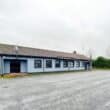The countdown is on for the largest and most spectacular partial solar eclipse in almost 90 years – but health officials are warning of very real dangers if people do not heed advice.
The moon will begin to pass in front of the sun at 8.26am tomorrow (Friday) morning.
Armagh Observatory has confirmedthat the big event will be the biggest partial eclipse visible over the Province since 1927!
And it will last over two hours – until 10.38am.
This is the first such eclipse visible from Northern Ireland since 2008, and the next similarly ‘deep partial eclipse’ will not occur until 2026 and then 2090!
Astronomers across the island of Ireland are preparing to observe the eclipse, and some are hosting special eclipse parties to show school groups and the general public the fascinating phenomenon.
Armagh Observatory will be opening its doors from 8.30am on the morning of the eclipse to explain the event and to show people how to observe it safely.
But for those not going to the Observatory, taking heed of advice issued today by the Public Health Agency is crucial.
Throughout the UK and Ireland there the eclipse will be peaking at around 9.30am.
At this time some 93.1 per cent of the sun will be obscured in Belfast, and a little more, 94.4 per cent, will be obscured on the North Coast.
The Irish Astronomical Association says that at no time during a partial eclipse is it safe to look at the sun directly – viewing even seven per cent or less of the sun will cause serious eye damage.
This is endorsed by the Public Health Agency (PHA) and the Health and Social Care Board (HSCB), which are urging everyone to exercise caution and are highlighting the dangers of looking directly at the sun during the eclipse.
Dr Jackie McCall, Consultant in Public Health at the PHA, said: “Whilst a solar eclipse is an amazing and infrequent event, the public must remember that looking directly at the sun can lead to retinal burns and permanent loss of sight.
“Looking directly at the eclipse is the same. An eclipse is a relatively slow process, so people might end up accidentally looking at the sun for minutes.”
The advice is to be careful and to follow these steps:
- never look at the sun with the naked eye;
- the eclipse should NOT be viewed through a camera lens, binoculars, or a telescope;
- it should not be viewed through smoked glass, stacked sunglasses, polarised shades or photographic filters;
- do not try to take a ‘selfie’ – it could potentially put you at risk as you may end up accidentally looking directly at the sun while aligning yourself and your phone.
- observe children, they should not be allowed to look directly at the sun at any time.
The Royal Astronomical Society has issued information on the safest ways to view the eclipse. They include using a pinhole camera to project an image of the eclipse on to a piece of card.
Other options involve using colanders to make multiple pinholes or using specifically-designed eclipse viewing glasses. More information is available on their website.
Raymond Curran, Head of General Ophthalmic Services at Health and Social Care Board, said: “Solar burns to the retina are not painful and the loss of vision is not always immediate.
“It can take hours or days to develop and there is unfortunately no treatment for it. Once the eye has been damaged the damage is irreversible.
“Enjoy the spectacle of the solar eclipse but be aware of the dangers and keep your eyes safe from harm.”
Read more news:
Shock at vile carcass dumping at county Armagh beauty spot
£70,000 boost for Sean Doran boxing club in Keady
William Irwin backs Unionist pact and urges ‘maximum turnout’




